当前位置:网站首页>Signal feature extraction +lstm to realize gear reducer fault diagnosis -matlab code
Signal feature extraction +lstm to realize gear reducer fault diagnosis -matlab code
2022-07-07 22:30:00 【Eva215665】
1. Data description
Gearbox data from PHM2009 Data challenge in , Official website :PHM2009 Data challenge . The tested gears include a set of spur gears and helical gears , In this example, the data of spur gear is used for verification . The photos of the experimental equipment are as follows .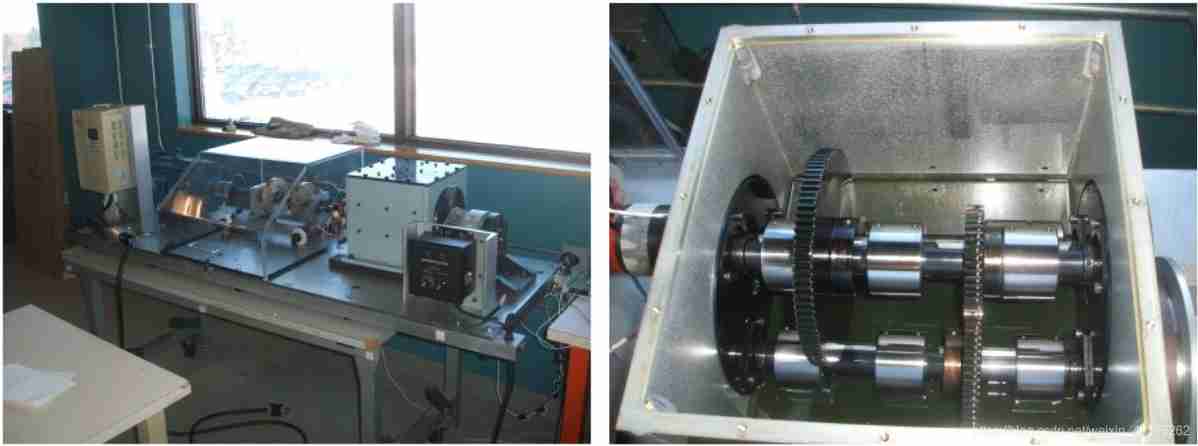
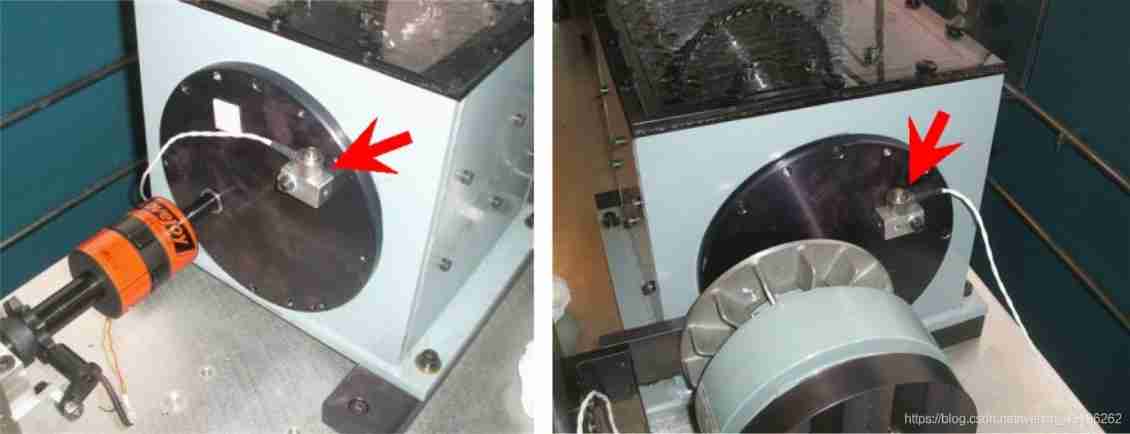
An acceleration sensor is installed on the input side and output side of the gearbox , Sensor parameters : sensitivity :10mv/g, Sampling rate 66.67KHz. The acquisition card used collects data from three channels , Respectively :
- passageway 1: Input side vibration sensor data
- passageway 2: Output side vibration sensor data
- passageway 3: Speed signal
Manually inject faults , share 8 Fault types , The following table .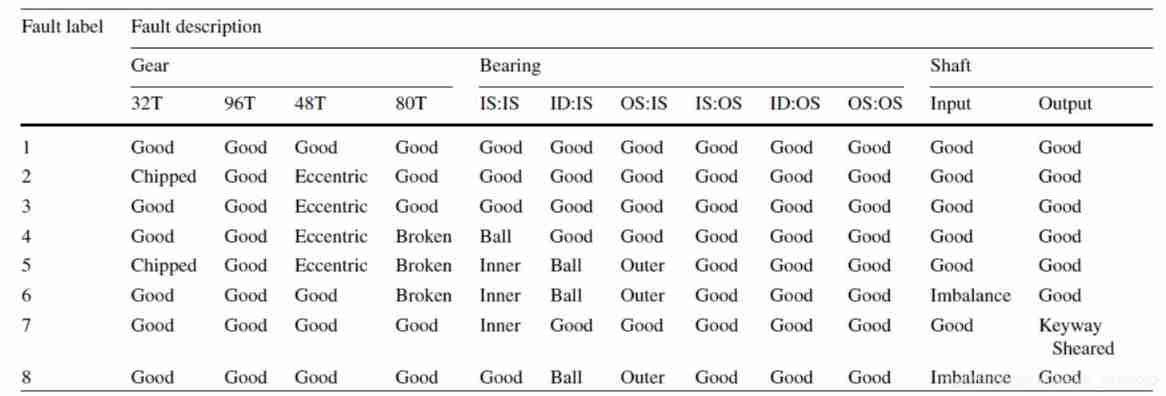
The working condition during the experiment is : The speed is set to 1800rpm, 2100rpm, 2400rpm, 2700rpm, 3000rpm, The loads are low load and high load respectively , After crossing, there are 10 Three working conditions , Respectively
1800 rpm | Low load ,1800rpm| High load , And so on .
This example uses 1800rpm| High load experimental data modeling and verification , Use channel two, that is, the output side vibration sensor data . Data acquisition of each fault type under each working condition lasts 8 second , So for each fault type , Each channel gets a total of 66.7KHz×8 second =533307 Data points . The data of each fault type is 533307×3 Matrix of channels , The data is in matlab Open as follows .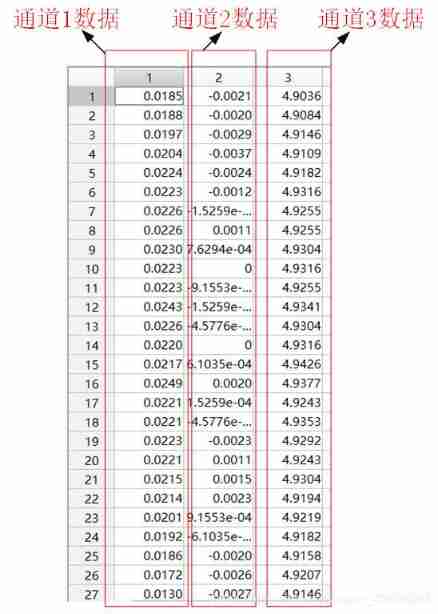
Put the channel 2 The data of plot come out , As shown below .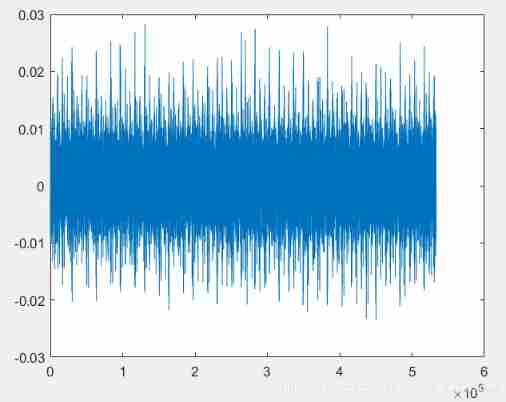
2. Code details
The code consists of two .m file
- read_data_1800_High.m
- main_1800_High.m
The first one is used to read and divide the original data
The second one is used to complete the division of training set and test set , feature extraction + Classification, etc
2.1 read_data_1800_High
// This function Input by
// interval - Data partition length , The default is 6400, That is, every 6400 Data points are divided into a sample
// ind_column - passageway , The default is 2, That is, select the second channel
// Output by
// label1 label2, ..., label8, They are divided into 8 Samples of fault types
%
function [label1 label2 label3 label4 label5 label6 label7 label8]= read_data_1800_High( interval, ind_column )
if nargin <2
ind_column=2; // If the argument passed is less than 2 individual , Default ind_column by 2
end
if nargin <1
interval=6400; // Default interval=6400
end
file_rul='E:\Datasets\PHM data challenge\2009 PHM Society Conference Data Challenge-gear box\spur_30hz_High\';
// Here's how to get file_rul Under the path .mat All files in format
file_folder=fullfile(file_rul);
dir_output=dir(fullfile(file_folder,'*.mat'));
file_name={
dir_output.name}';
num_file=max(size(file_name)); //num_file Is the number of files , In this case num_file=8,8 File , Store the... Of the gearbox separately 8 Kinds of fault data
for i=1:num_file
file=[file_rul,file_name{
i}];
load(file);
[filepath, name, ext]=fileparts(file);
raw=eval(name);
// Every time 6400 Points are divided into one sample
n=1;
left_index=1+(n-1)*interval;
right_index=n*interval;
while right_index<=size(raw,1)
temp=raw(left_index : right_index, ind_column);
// eval The function structure label1, label2,... And so on
eval(['label' num2str(i) '(:,n)=temp;']);
n=n+1;
left_index=1+(n-1)*interval;
right_index=n*interval;
end
end
end
2.2 main_1800_High
// Reading data ,label1 For one 6400*83 Array of ,83 The number of samples obtained for each fault type
[label1, label2, label3, label4, label5, label6, label7, label8]=read_data_1800_High();
num_categories=8;
// because matlab in LSTM Modeling requires , use num2cell Function will label1 To cell type ,label_x_cell For one 1×83 Of cell Type of the array , Every cell Storage 6400 Data points
label1_x_cell=num2cell(label1,1);
label2_x_cell=num2cell(label2,1);
label3_x_cell=num2cell(label3,1);
label4_x_cell=num2cell(label4,1);
label5_x_cell=num2cell(label5,1);
label6_x_cell=num2cell(label6,1);
label7_x_cell=num2cell(label7,1);
label8_x_cell=num2cell(label8,1);
num_1=length(label1_x_cell);
num_2=length(label2_x_cell);
num_3=length(label3_x_cell);
num_4=length(label4_x_cell);
num_5=length(label5_x_cell);
num_6=length(label6_x_cell);
num_7=length(label7_x_cell);
num_8=length(label8_x_cell);
// Create a data structure for storing labels of each fault type , because matlab in lstm Modeling requires , Also needed cell Type data . for example ,label1_y For one 83×1 Of cell Type of the array , At present, its value is empty
label1_y=cell(num_1,1);
label2_y=cell(num_2,1);
label3_y=cell(num_3,1);
label4_y=cell(num_4,1);
label5_y=cell(num_5,1);
label6_y=cell(num_6,1);
label7_y=cell(num_7,1);
label8_y=cell(num_8,1);
// Create a label for the fault type , use 1,2,3,...,8 Express 8 A fault tag , Assign a value to the corresponding tag .
for i=1:num_1; label1_y{
i}='1'; end
for i=1:num_2; label2_y{
i}='2'; end
for i=1:num_3; label3_y{
i}='3'; end
for i=1:num_4; label4_y{
i}='4'; end
for i=1:num_5; label5_y{
i}='5'; end
for i=1:num_6; label6_y{
i}='6'; end
for i=1:num_7; label7_y{
i}='7'; end
for i=1:num_8; label8_y{
i}='8'; end
// use dividerand The function randomly divides the data of each fault type into 4:1 The proportion of , For training and testing respectively
[trainInd_label1,~,testInd_label1]=dividerand(num_1,0.8,0,0.2);
[trainInd_label2,~,testInd_label2]=dividerand(num_2,0.8,0,0.2);
[trainInd_label3,~,testInd_label3]=dividerand(num_3,0.8,0,0.2);
[trainInd_label4,~,testInd_label4]=dividerand(num_4,0.8,0,0.2);
[trainInd_label5,~,testInd_label5]=dividerand(num_5,0.8,0,0.2);
[trainInd_label6,~,testInd_label6]=dividerand(num_6,0.8,0,0.2);
[trainInd_label7,~,testInd_label7]=dividerand(num_7,0.8,0,0.2);
[trainInd_label8,~,testInd_label8]=dividerand(num_8,0.8,0,0.2);
// Build training data for each fault type
xTrain_label1=label1_x_cell(trainInd_label1);
yTrain_label1=label1_y(trainInd_label1);
xTrain_label2=label2_x_cell(trainInd_label2);
yTrain_label2=label2_y(trainInd_label2);
xTrain_label3=label3_x_cell(trainInd_label3);
yTrain_label3=label3_y(trainInd_label3);
xTrain_label4=label4_x_cell(trainInd_label4);
yTrain_label4=label4_y(trainInd_label4);
xTrain_label5=label5_x_cell(trainInd_label5);
yTrain_label5=label5_y(trainInd_label5);
xTrain_label6=label6_x_cell(trainInd_label6);
yTrain_label6=label6_y(trainInd_label6);
xTrain_label7=label7_x_cell(trainInd_label7);
yTrain_label7=label7_y(trainInd_label7);
xTrain_label8=label8_x_cell(trainInd_label8);
yTrain_label8=label8_y(trainInd_label8);
// Build test data for each fault type
xTest_label1=label1_x_cell(testInd_label1);
yTest_label1=label1_y(testInd_label1);
xTest_label2=label2_x_cell(testInd_label2);
yTest_label2=label2_y(testInd_label2);
xTest_label3=label3_x_cell(testInd_label3);
yTest_label3=label3_y(testInd_label3);
xTest_label4=label4_x_cell(testInd_label4);
yTest_label4=label4_y(testInd_label4);
xTest_label5=label5_x_cell(testInd_label5);
yTest_label5=label5_y(testInd_label5);
xTest_label6=label6_x_cell(testInd_label6);
yTest_label6=label6_y(testInd_label6);
xTest_label7=label7_x_cell(testInd_label7);
yTest_label7=label7_y(testInd_label7);
xTest_label8=label8_x_cell(testInd_label8);
yTest_label8=label8_y(testInd_label8);
// Integrate the data of each fault type , Build a complete training set and test set
xTrain=[xTrain_label1 xTrain_label2 xTrain_label3 xTrain_label4 xTrain_label5 xTrain_label6 xTrain_label7 xTrain_label8];
yTrain=[yTrain_label1; yTrain_label2; yTrain_label3; yTrain_label4; yTrain_label5; yTrain_label6; yTrain_label7; yTrain_label8];
num_train=size(xTrain,2);
xTest=[xTest_label1 xTest_label2 xTest_label3 xTest_label4 xTest_label5 xTest_label6 xTest_label7 xTest_label8];
yTest=[yTest_label1; yTest_label2; yTest_label3; yTest_label4; yTest_label5; yTest_label6; yTest_label7; yTest_label8];
num_test=size(xTest,2);
//================================================================================
// The following is for each sample , Extract three features :1. Instantaneous frequency ,2. Instantaneous spectral entropy ,3. Wavelet packet energy ,
// The above three features will then be sent to the classifier for classification , Experimental results show that , Take wavelet packet energy as a feature ,
// It can achieve the highest classification accuracy
// Extract instantaneous frequency : use matlab Of pspectrum Perform spectral decomposition on each sample , Reuse instfreq Function to calculate the instantaneous frequency
FreqResolu=25;
TimeResolu=0.12;
// the output of pspectrum 'p' contains an estimate of the short-term, time-localized power spectrum of x.
// In this case, p is of size Nf × Nt, where Nf is the length of f and Nt is the length of t.
[p,f,t]=cellfun(@(x) pspectrum(x,fs,'TimeResolution',TimeResolu,'spectrogram'),xTrain,'UniformOutput', false);
instfreqTrain=cellfun(@(x,y,z) instfreq(x,y,z)', p,f,t,'UniformOutput',false);
[p,f,t]=cellfun(@(x) pspectrum(x,fs,'TimeResolution',TimeResolu,'spectrogram'),xTest,'UniformOutput', false);
instfreqTest=cellfun(@(x,y,z) instfreq(x,y,z)', p,f,t,'UniformOutput',false);
// Extract instantaneous spectral entropy : use matlab Of pspectrum Perform spectral decomposition on each sample , Reuse pentropy Function to calculate the instantaneous frequency
[p,f,t]=cellfun(@(x) pspectrum(x,fs,'TimeResolution',TimeResolu,'spectrogram'),xTrain,'UniformOutput', false);
pentropyTrain=cellfun(@(x,y,z) pentropy(x,y,z)', p,f,t,'UniformOutput',false);
[p,f,t]=cellfun(@(x) pspectrum(x,fs,'TimeResolution',TimeResolu,'spectrogram'),xTest,'UniformOutput', false);
pentropyTest=cellfun(@(x,y,z) pentropy(x,y,z)', p,f,t,'UniformOutput',false);
// Extract wavelet packet energy
// num_level=5 Represents the five layer decomposition of wavelet packets , Get... Together 2^5=32 An eigenvector composed of values .
num_level=5;
index=0:1:2^num_level-1;
// wpdec Is the wavelet packet decomposition function
treeTrain=cellfun(@(x) wpdec(x,num_level,'dmey'), xTrain, 'UniformOutput', false);
treeTest=cellfun(@(x) wpdec(x,num_level,'dmey'), xTest, 'UniformOutput', false);
for i=1:num_train
for j=1:length(index)
// wprcoef Reconstruct the function for wavelet coefficients
reconstr_coef=wprcoef(treeTrain{
i},[num_level,index(j)]);
// Calculate the energy
energy(j)=sum(reconstr_coef.^2);
end
energyTrain_doule(i,:)=energy;
end
energyTrain=num2cell(energyTrain_doule,2);
energyTrain=energyTrain';
for i=1:num_test
for j=1:length(index)
reconstr_coef=wprcoef(treeTest{
i},[num_level,index(j)]);
energy(j)=sum(reconstr_coef.^2);
end
energyTest_double(i,:)=energy;
end
energyTest=num2cell(energyTest_double,2);
energyTest=energyTest';
// =============== Assemble feature sequences for feeding into the classifier ====================
// The following statement only uses the wavelet packet energy as the input feature
xTrainFeature=cellfun(@(x)[x], energyTrain', 'UniformOutput',false);
xTestFeature=cellfun(@(x)[x], energyTest', 'UniformOutput',false);
// If you want to use Instantaneous spectral entropy and wavelet packet energy are used as inputs , as follows
// xTrainFeature=cellfun(@(x,y,z)[x;y;z],energyTrain',instfreqTrain', pentropyTrain', 'UniformOutput',false);
// xTestFeature=cellfun(@(x,y,z)[x;y;z], energyTest',instfreqTest',pentropyTest', 'UniformOutput',false);
// ============================ Data standardization ================================
XV=[xTrainFeature{
:}];
mu=mean(XV,2);
sg=std(XV,[],2);
xTrainFeatureSD=xTrainFeature;
xTrainFeatureSD=cellfun(@(x)(x-mu)./sg, xTrainFeatureSD,'UniformOutput',false);
xTestFeatureSD=xTestFeature;
xTestFeatureSD=cellfun(@(x)(x-mu)./sg,xTestFeatureSD,'UniformOutput',false);
// ========================= Design LSTM The Internet =================================
yTrain_categorical=categorical(yTrain);
numClasses=numel(categories(yTrain_categorical));
yTest_categorical=categorical(yTest);
sequenceInput=size(xTrainFeatureSD{
1},1); // If you chose 3 Features as data , Here instead "3"
// Create for sequence-to-label Classified LSTM Steps are as follows :
// 1. establish sequence input layer
// 2. Create several LSTM layer
// 3. Create a fully connected layer
// 4. Create a softmax layer
// 5. Create a classification outputlayer
// Pay attention to sequence input layer Of size Set to the number of feature categories included , In this case ,1 or 2 or 3, Depending on how many features you use .fully connected layer The parameter of is the classification number , In this case 8.
layers = [ ...
sequenceInputLayer(sequenceInput)
lstmLayer(256,'OutputMode','last')
fullyConnectedLayer(numClasses)
softmaxLayer
classificationLayer
];
maxEpochs=600;
miniBatchSize=32;
// If you don't want to show the training process ,
options = trainingOptions('adam', ...
'ExecutionEnvironment', 'gpu',...
'SequenceLength', 'longest',...
'MaxEpochs',maxEpochs, ...
'MiniBatchSize', miniBatchSize, ...
'InitialLearnRate', 0.001, ...
'GradientThreshold', 1, ...
'plots','training-progress', ...
'Verbose',true);
// ====================== Training network =========================
net2 = trainNetwork(xTrainFeatureSD,yTrain_categorical,layers,options);
// ====================== Test network ==========================
testPred2 = classify(net2,xTestFeatureSD);
// Print confusion matrix
plotconfusion(yTest_categorical',testPred2','Testing Accuracy')
Screenshot of the training process , If you don't want to show this figure , take options Medium 'plots','training-progress', ... Change it to 'plots','none', ...
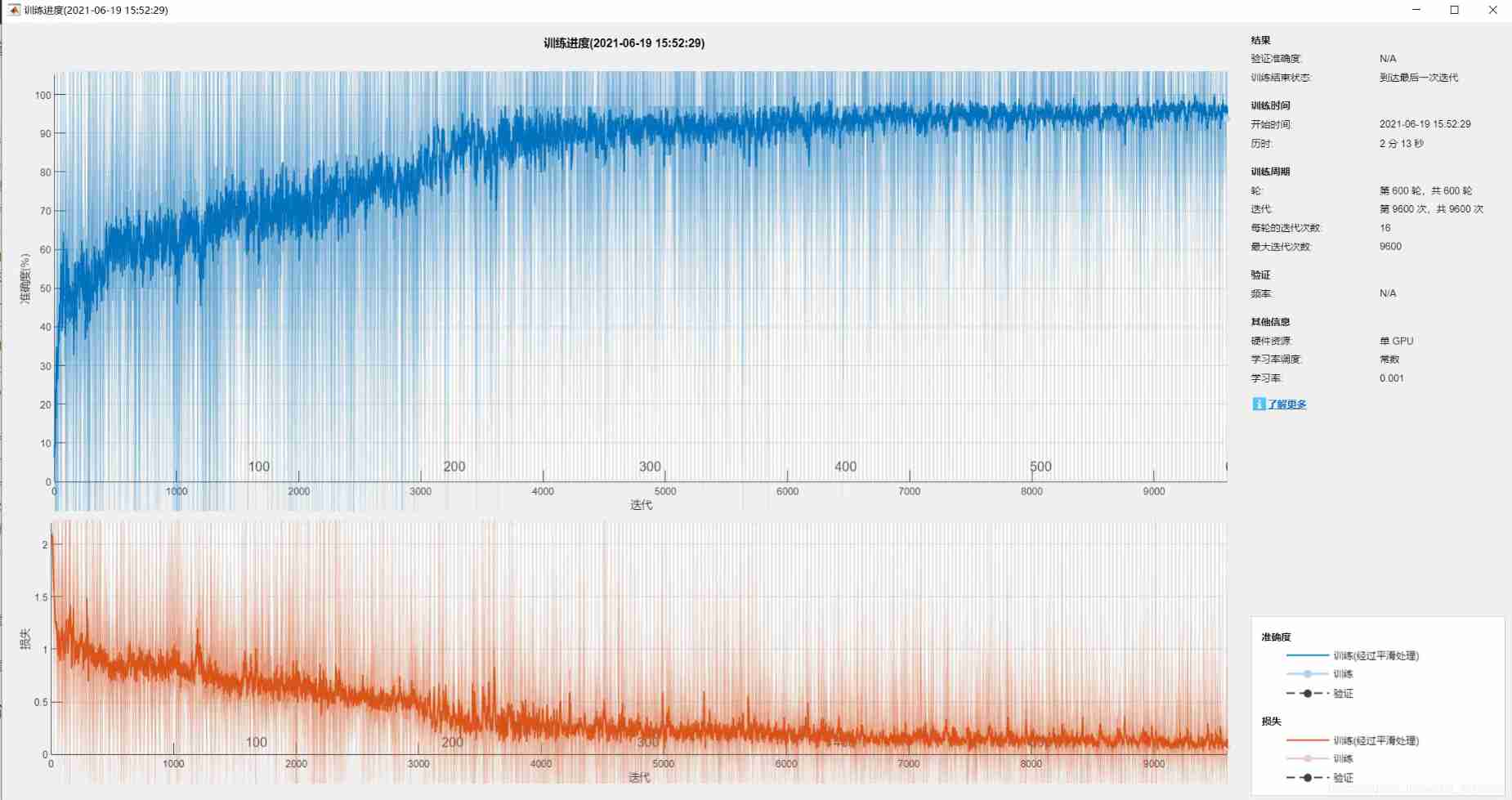
Screenshot of confusion matrix , You can see , Accuracy of 94%.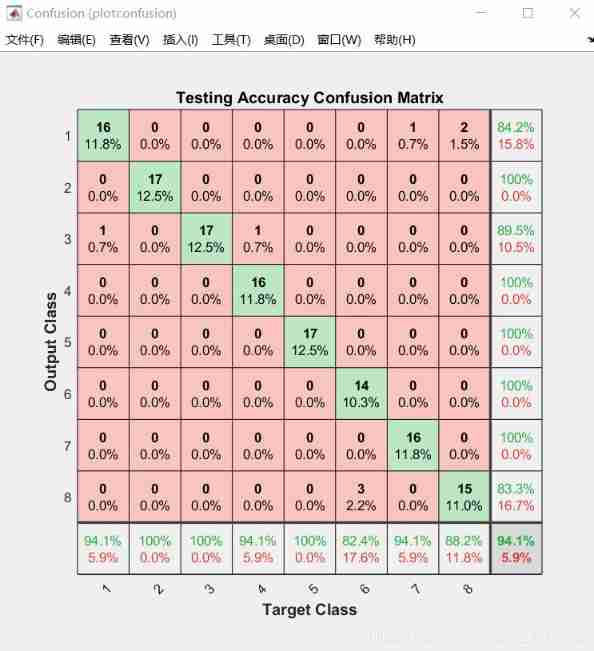
Put the above two files in the same workspace Next , function main_1800_High that will do
3 expectation
In the follow-up study , We found out keras Under the framework of deep learning CNN It's easier to do this kind of problem , Feature extraction is not required , The tutorial will be supplemented later .
边栏推荐
- UnicodeDecodeError: ‘gbk‘ codec can‘t decode byte 0xf9 in position 56: illegal multibyte sequence
- Pdf document signature Guide
- Dayu200 experience officer MPPT photovoltaic power generation project dayu200, hi3861, Huawei cloud iotda
- It's worth seeing. Interview sites and interview skills
- Relationship between URL and URI
- Remove the default background color of chrome input input box
- 100million single men and women "online dating", supporting 13billion IPOs
- 使用 CustomPaint 绘制基本图形
- 使用 BlocConsumer 同时构建响应式组件和监听状态
- Matplotlib quick start
猜你喜欢

Reinforcement learning - learning notes 9 | multi step TD target
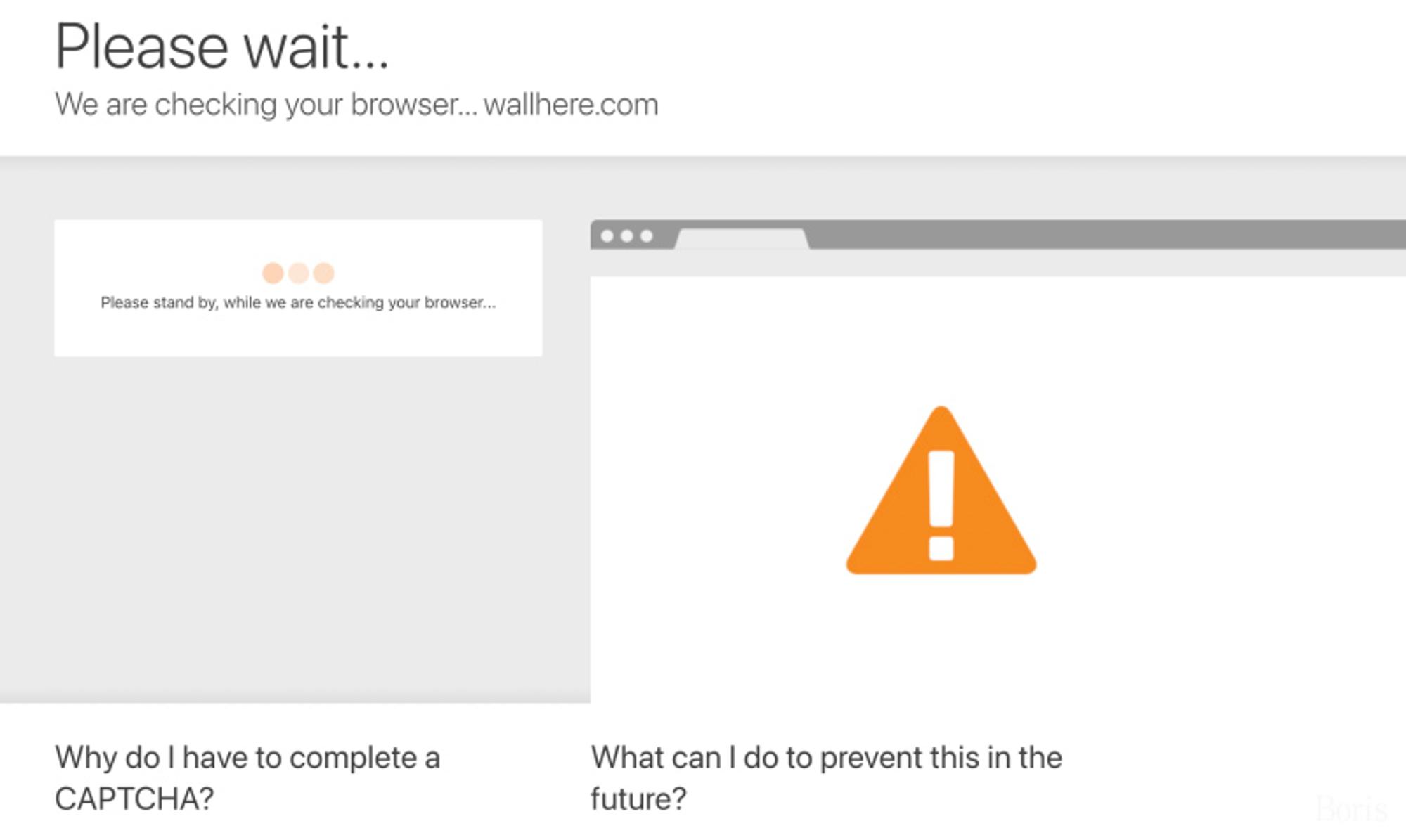
反爬通杀神器
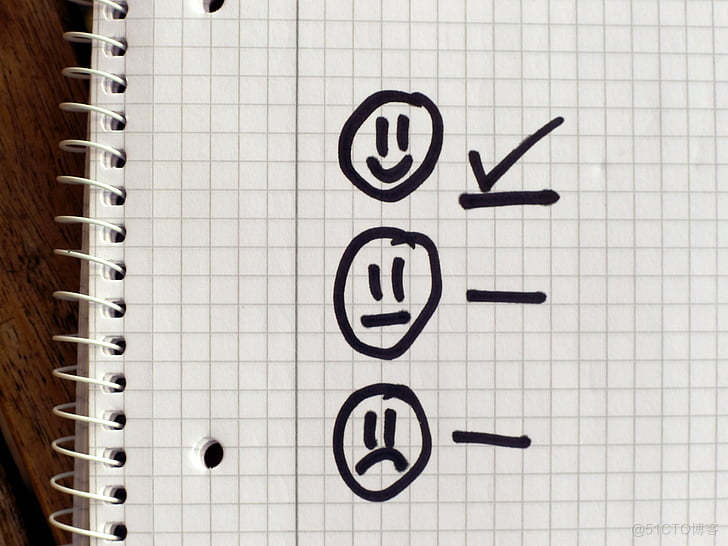
如何选择合适的自动化测试工具?

What does it mean to prefix a string with F?
![[advanced MySQL] index details (I): index data page structure](/img/e7/fe4591a721a71c3c38d6e4448af6af.png)
[advanced MySQL] index details (I): index data page structure

DNS series (I): why does the updated DNS record not take effect?
![[open source] Net ORM accessing Firebird database](/img/a2/4eff4f0af53bf3b9839a73019a212f.png)
[open source] Net ORM accessing Firebird database

Matplotlib快速入门

Dayu200 experience officer MPPT photovoltaic power generation project dayu200, hi3861, Huawei cloud iotda

Remember an experience of using selectmany
随机推荐
Variables and constants
Record layoutrebuild Forcerebuildlayoutimmediate does not take effect
苹果在iOS 16中通过'虚拟卡'安全功能进一步进军金融领域
Visual design form QT designer design gui single form program
ByteDance Android interview, summary of knowledge points + analysis of interview questions
Reinforcement learning - learning notes 9 | multi step TD target
Gazebo import the mapping model created by blender
SAR image quality evaluation
谈谈制造企业如何制定敏捷的数字化转型策略
OpenGL job - texture
Tsconfig of typescript TS basics JSON configuration options
[interview arrangement] 0211 game engine server
海外代理推荐
PKPM 2020软件安装包下载及安装教程
【Azure微服务 Service Fabric 】如何转移Service Fabric集群中的种子节点(Seed Node)
客户案例|华律网,通过观测云大幅缩短故障定位时间
怎样写一个增广矩阵到txt文件中
使用 CustomPaint 绘制基本图形
Revit secondary development - operation family documents
Matplotlib快速入门